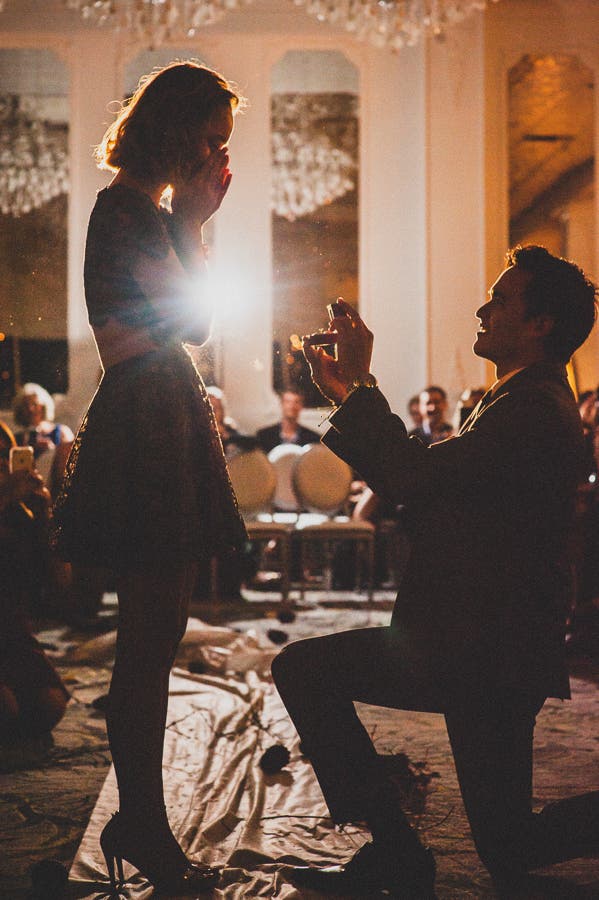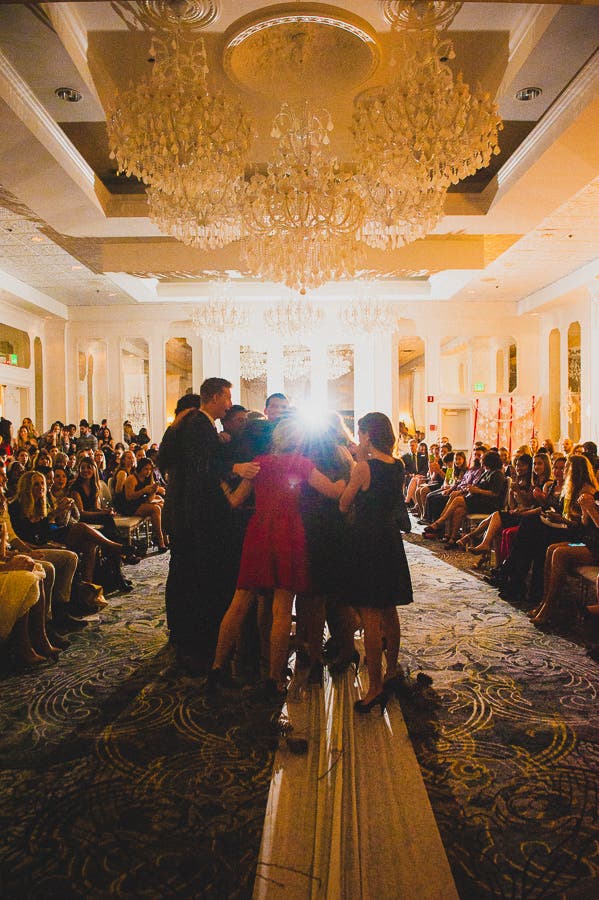One of the most quickly-growing photography trends is proposal coverage. For a photographer tasked with getting great candid coverage and staying hidden, this job can be quite stressful because there are so many unexpected factors to juggle.
I think excellent documentation of a proposal is 90 percent preparation and 10 percent making the right decisions in the moment, so here are a few tips to help you prepare to get that perfect proposal shot.

Communication is everything
When a Proposer first contacts you, you’ll want to find out the following:
- When & where do they want to pop the question? Find out what the light situation will be in this case and suggest adjustments accordingly. Will it be daytime? Dusk with streetlights? Indoors with tungsten or fluorescent lights, or candlelit? Can you hand-hold your camera or will you need a tripod? (If it’s so dark that a flash will be needed, keeping your presence a secret isn’t likely.)
- If the Proposer is flexible about the time and place, suggest a location and time of day that will allow you to have the best chance of creating fantastic images. Often this means outdoors, somewhere pretty and not too busy, during the day when the sun isn’t straight overhead but is still above the trees, and surrounded by something behind which you can hide (trees, landscaping, people, buildings, etc.).

Dry run (and more communication)
Once you have the time and place nailed down, you’ll want to do a dress rehearsal of sorts with the Proposer, preferably at the same time of day as the actual proposal will occur. Where will the Proposer stand when they ask the question? Can this be discreetly marked with a piece of tape, golf tee, tennis ball, volunteer friend stand-in? Will they kneel? How will they get the Proposee in the right place so their reaction can be seen and photographed?

If it’s a public place, you’ll want to have a backup location to shoot from, even if it’s just a few feet away, just in case a crowd develops or some well-meaning passerby decides to do their own iPhone documentation of the event. If the proposal will take place in a business like a restaurant or tourist attraction, it’s a good idea to communicate with a staff member beforehand about your plans.
Finally, ask what the Proposer wants you to do if all your well-laid plans fall apart? Step into plain view and get the shot or stay hidden and do the best you can (explaining that this might mean obstructed view/too dark images, etc.)?

Gear & prep
For unrepeatable moments like proposals (you have one shot at this), you need to have dependable gear and a full set of backups within arm’s reach. Often a proposal may not last more than a minute from start to finish, so your backup camera and lens should be assembled and on, memory cards in and formatted, so that if your first camera fails all you have to do is pick up your backup and start shooting.
Telephoto lenses are especially useful for proposals because no matter how many times you practice with the Proposer, that person will probably be nervous and might not remember everything they need to do, so you may need to make last-second adjustments to get the shot. When you can’t physically correct your position because of lack of space or without giving yourself away, an adjustable lens can come to the rescue! (Try the fantastic all-purpose Nikon 24-70 f/2.8 or the Nikon 70-200 2.8 VRII).

On the day of:
Wear clothes that match your hiding place and that you don’t have to worry about getting dirty. If you live in a place with unpredictable weather, you might arrive to find your fabulous hiding spot under an inch of muddy water.
Be sure your phone is off or silent. If it’s a busy park, this probably won’t make a difference, but if it’s a library, museum, or quiet forest trail even your phone’s vibration sound is loud enough to give you away.
Tape down built-in pop-up flashes to avoid accidental detonation.

In the photos shown in this article, my client, David, wanted to surprise his girlfriend, Kayla, by proposing at the end of a fashion show at which she was working. It wasn’t odd for someone to be photographing with professional gear, so I didn’t need to stay hidden, but I still made careful plans with David ahead of time, finding out exactly when, where, and how he wanted to propose.
He enlisted the help of some of her friends to help guide Kayla’s hair and clothing choices as well as to make sure she was seated next to the runway and near the stage. Since it was indoors, I set up a remote-detonated off-camera flash, just in case the runway spotlight wasn’t enough to freeze motion. Since David chose such a public place to propose I wanted to include the reactions of the other attendees rather than the stage curtains behind them, so I positioned myself with my back to the stage, shooting into the stage light and my speedlight. This position also made for some nice romantic images with the flash spilling over both their shoulders.

The gear I used:
- Nikon D4s
- Nikon D810
- Nikon 24-70mm f/2.8
- Nikon 35mm f/1.4
- Nikon SB-910 speedlight
- Pocket Wizard TT5 for Nikon
- Pocket Wizard Mini TT1 for Nikon
- Pocket Wizard AC3 Zone Controller for Nikon
- Free sliding light stand with Cold Shoe for Speedlight
For more inspiration, check out the whole series on my blog.




